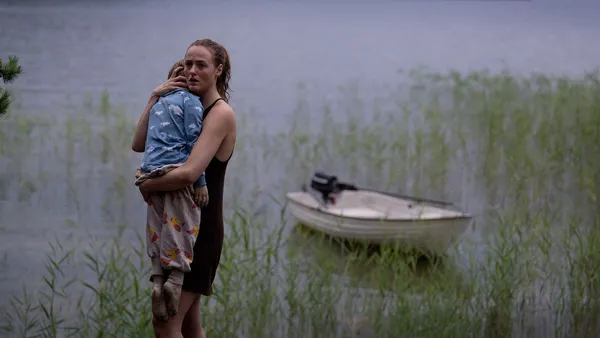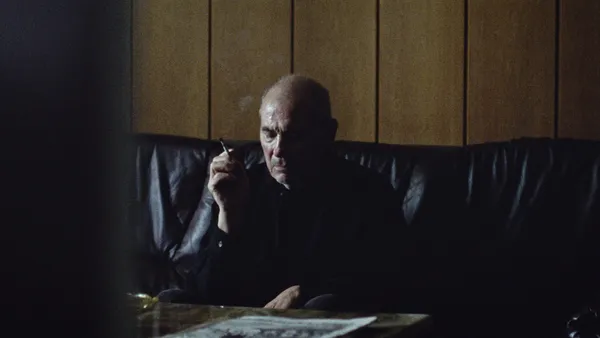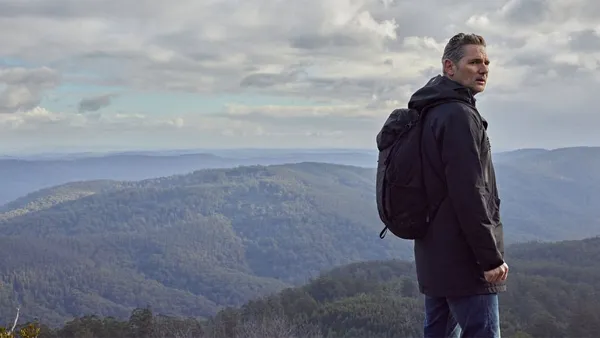Zombie movies traditionally involve lurching cadavers and adrenaline-rush horror. Thea Hvistendahl takes an altogether slower and more sorrowful approach with her debut Handling The Undead, which is adapted by Let The Right One In’s John Ajvide Lindqvist from his own book. The drip of dread and the horror of grief come together in this trio of tales in which, after a strange event in a hot Oslo summer, families find their loved ones rising from the grave. In one corner of the city, Renate Reinsve’s Anna and her father (Bjørn Sundquist) try to help her son, with his rasping breath and buzzing flies telling us all we need to know about how long he has been dead. Elsewhere, the dead partner (Olga Damani) of Tora (Bente Børsum) arrives on her doorstep, while in the third story an accident leaves Anders Danielsen’s David and his family facing an uncertain future.
Hvistendahl takes a spare approach to the genre that leaves room for the amplified and disturbing sound design and Peter Raeburn’s ominous and gradually crescendoing score to do their work. Raeburn was awarded a Sundance Special Jury prize for the score, with the Jury saying: “This propulsive and sweeping score achieved a haunting atmosphere that carried the emotional heartbeat of this indelible film”.
When we caught up with Raeburn to talk about his approach to the scoring he says the win at Sundance came as a complete surprise, but one that carried personal significance.
“I was completely thrilled as it was my late mother's birthday when I got the call. I see it very much as her birthday present to me. I was absolutely flabbergasted. There isn't a musical award at Sundance so it wasn't even in that place. It’s very much a shared award with the whole team. I am still somewhat in disbelief.”
Turning to the film itself, we asked him how hard it was to resist filling all the space that he has been given in the film, instead judiciously allowing the mood to build.
“I think it's easier to to have space and silence once you've got the right material, it's when the material isn't quite right, for whatever reasons that it feels like it needs to apologise by having more of it, and then more of it, and then you're kind of on to a losing streak, in which case, people just have loads of music, and not sure why. It's a bit like a dysfunctional relationship, they just keep on going even though you wish you’d never met in the first place.
“So in this case, myself and Thea the director worked hard to try to find the right material, the material that she felt was inevitable, and ‘it’. The first cue in the film is not very long. I'm normally quite against short cues, I find they can be really annoying. Somehow that first cue in the film says so much in such a short amount of time. And that sets up our stall. It says that we don't need to be musically verbose, because there's a lot to take in. It's a bit like having a ginger shot rather than tons of it. And so I think that first cue, she fell in love with that. It starts with some strings but even between the phrases, there's space, even in the very writing there’s air. There's not just like a big old mouthful. And then and then it goes to this kind of everlasting bassy drone thing.”
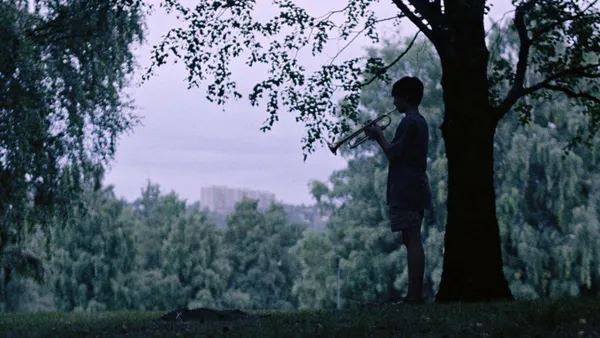 |
| Peter Raeburn: 'When a film can breathe, it's a lot easier to bring things together' Photo: Courtesy of Sundance Institute |
That drone has an electro vibe but that’s just the beginning for a score that opens out into something much more orchestral and melancholic. It’s a combination that you don’t encounter so frequently but Raeburn says that to him “they are part of the same world”.
He explains: “The bassier world, the throbbier world, is all made from organic instruments. So there's nothing there's nothing synthetic in there. I make those noises for each project I work with these hands. There's all kinds of things, woodwinds and tuned down harmonics from double basses, pure sine waves I use and I mix all these things together kind of like in a, in a kind of Magimix thing of some kind, and then create something that is a compound sound. The way it throbs, the way it pulses changes through the film. Just when you think you’re in one tempo, it can shift. I use loads of different filters to kind of try to create a quality so they have a physicality to them rather than feeling like it's synthetic.”
Physicality is prominent in this slow-burn film, with sound design dovetailing with the score to add to the general feeling of unease, as the ambiguity around the dead grows. Raeburn says that constructive collaboration is vital to achieve the right result.
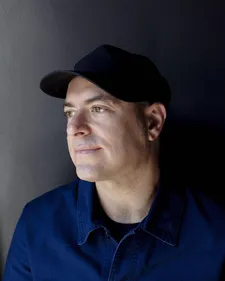 |
| Peter Raeburn: 'It's a very challenging film, in terms of its subject matter you have to be prepared to go there, I can't dial that stuff in' |
“You can't get into an ego battle,” he says. “When you're working on a film like this, it's like being part of a band, and I play one instrument, someone else plays another and everyone's very respectful. That's the first thing. There's always crossover. I made a lot of kind of musical atmospheres, that are throughout the film that you may not have said, ‘That’s score’, but it's there. That helps those people out, because it's in tune with what's going to happen and makes sure everything's kind of sympathetic to what's about to happen, or deliberately unsympathetic. So I helped them out a lot and they helped me a lot and it's a really good collaboration.
“There was a sound that I made very early on, and it just simply called it ‘dead people’. And I don't know why I call it that. It was a kind of using voices but you can't really tell it’s voices unless you really pick the layers apart. It just feels like dead people but it has a life to it. It's almost like if you could imagine a calling from elsewhere, from another timezone, another another, another world, an afterlife of some kind. There's a scene where the grandfather is digging his grandson up, and this is as if those people made music - if they breathed what would that sound like? Thea really got attached to that sound. It felt like there's a mood to it so that helps us all to have that. Similarly by not having music continually, the sound team are able to really go for it when they want to. It's a very respectful working relationship.”
Turning to the start of the project, Raeburn says the collaboration with Hvistendahl began with her showing him some images in terms of how she wanted the film to look, along with photos of some of the actors, although there were no musical references at that point.
He recalls: “Sometimes you have a conversation with someone, and it's fairly clear that you just want to work together. And it was just one of those conversations. I think that we're both very open emotionally about our experiences. It's a very challenging film, in terms of its subject matter you have to be prepared to go there, I can't dial that stuff in. I never would have been able to write a score like this without going there and having had my experiences with grief, and being able to bring those in a non-manipulative way into the work.
“So through the conversation, I just started doing some sketching. And it's literally sketching, it's sitting in a quiet place and I'm going to describe it in terms of being a physical artist rather than a musical artist. I start to get some colors together and some feelings and just see what comes out. And Thea ended up shooting to that music in her headphones and in the headphones of her amazing cinematographer. And you can tell. Then the footage started coming back to me and it had that music on it and, again, we don't really use that music that much in the film, bits of it are there, but that's a true lovely process.”
That’s a fairly unusual way of working, since frequently the composer is brought in towards the end of the project often with a temporary track of music included on the film.
Raeburn describes it as “a proper one to one, two” as they passed the music back and forth.
He adds: “This particular process was unique in that way. There wasn't any temp music, there wasn't any other people's music ever. I think especially dealing with the grieving mother, how to handle Renate’s performance, figuring out how to frame that performance. So it's almost like infusing the energy of the film, so that we don't need it the whole way through.”
The film is built upon space, that opened up by grief between the living characters, the gap between the living and the dead and between the sound and the music. Raeburn also notes that the dialogue for the film is also spare.
He says: “One of the most powerful experiences when people go through grief that no one really talks about is the silence and the loneliness and I think Thea was brave to go there.”
Giving an illustration of how hands on the Norwegian director is, he talks about a scene which he says used one of his “early sketches”.
He explains: “It was as if everyone was almost addicted to the music in that scene. And quite late in the process. Thea was like, ‘I'm not sure about any more’. That’s the sign of an amazing director. That’s not an indecisive director, that’s a director who is always striving beyond what we’ve got and knows, what if there's something else in me as a composer that could come out that we haven't heard yet. What would that be?
“So she asked me to just think about that and I'm so pleased she did because there's no way the film would have been what it is without that move on her part. I went into a slightly more vulnerable place and started working with some solo violin. And that's a real character in the film even though it's with other instruments. It's just so beautiful and vulnerable. And I think it's a big, big part of the score. Same with a cello. So I think that the ability to hear individuality within the score is something that came through in that last stage, it was more emotional in a way.”
Another challenge of the film is its triptych structure, which means the stories have to be woven together by the music while also retaining their individualism.
Raeburn says forging those links is “a big part of what we do” as composers. He adds: “When a film can breathe, it's a lot easier to bring things together. It's when there's too much music it’s a little harder, then it can become quite saturated. But I think in this case, there's enough space to be able to see the similarities in the triptych, to feel like they're all breathing the same air is what I wanted but they’re not necessarily on the same wavelength.”
The composer, whose scores also include The Dry and Photograph, says there’s a “muscle to these undead”. Speaking of the slipperiness of the film when it comes to genre, as it relies more on psychological horror that what is shown onscreen, he adds: “If it’s horror-y in any way, it’s because the death of a loved one is horrible. It's horrible to lose people that we love and that can often feel very cheesy or can often feel very scary but actually it’s just sore. Most of the score is actually quite loving. This is all connected with how we deal with grief and how we deal with loss of loved ones. And I think my experience is that we continue to love the people that we've lost and that can be beautiful, as well as horrible.”
Beyond the work on Handling The Undead, Raeburn is working on Robert Connolly’s sequel to The Dry called Force Of Nature, which will see Eric Bana reprise his central role.
He says: “It's an epic journey of a group of women who are in a kind of corporate retreat in the Australian wild bush. And it all goes tits up. So it's a kind of survivalist picture. I loved that project. There's a larger scale orchestra, for sure. It was all about the force of nature, about the relationship between humanity and the elements. I'm very interested in that, and how they all work together. It's definitely got a lot more momentum and tension. Like The Dry, Eric Bana’s character is visiting his own past and uncovering a massive murder mystery at the same time. So it is the same, weaving together two or more timelines and trying to do that without feeling like anyone's doing their shoe laces up the wrong way.
“I also think it is important to mention the performances from actors and how delicate the work is for me as a composer to not tread on them and not contradict them and to try to occupy the essential interior emotional performance without patronising an audience in any way. To go back to your question about space, in the end, it is about collaborating with actors and so when I meet actresses or actors or afterwards, they don't know who I am necessarily, but I know who they are. I've studied very hard, how they move and how they talk and try to work that.
“Ultimately an amazing bit of work is bigger than the sum of his parts. I really try to create a new thing every time. So no one film has any negative baggage from another. So I try and refresh my cache because otherwise you can fall into repetition. It's really about a film having its voice and the director having his or her voice. So I want to facilitate that.”
- Read what Thea Hvistendahl told us about making Handling The Undead








